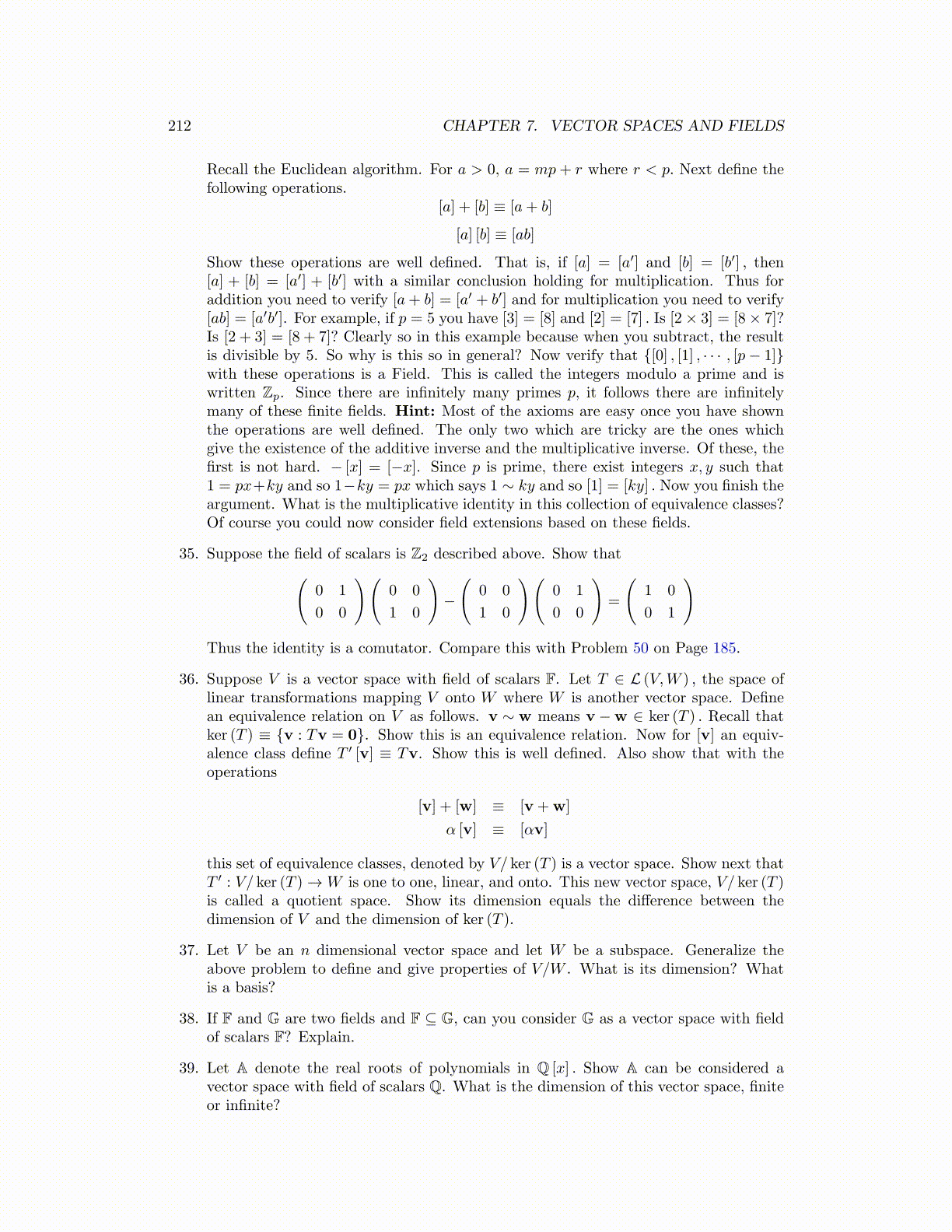
212 CHAPTER 7. VECTOR SPACES AND FIELDS
Recall the Euclidean algorithm. For a > 0, a = mp+ r where r < p. Next define thefollowing operations.
[a] + [b] ≡ [a+ b]
[a] [b] ≡ [ab]
Show these operations are well defined. That is, if [a] = [a′] and [b] = [b′] , then[a] + [b] = [a′] + [b′] with a similar conclusion holding for multiplication. Thus foraddition you need to verify [a+ b] = [a′ + b′] and for multiplication you need to verify[ab] = [a′b′]. For example, if p = 5 you have [3] = [8] and [2] = [7] . Is [2× 3] = [8× 7]?Is [2 + 3] = [8 + 7]? Clearly so in this example because when you subtract, the resultis divisible by 5. So why is this so in general? Now verify that {[0] , [1] , · · · , [p− 1]}with these operations is a Field. This is called the integers modulo a prime and iswritten Zp. Since there are infinitely many primes p, it follows there are infinitelymany of these finite fields. Hint: Most of the axioms are easy once you have shownthe operations are well defined. The only two which are tricky are the ones whichgive the existence of the additive inverse and the multiplicative inverse. Of these, thefirst is not hard. − [x] = [−x]. Since p is prime, there exist integers x, y such that1 = px+ky and so 1−ky = px which says 1 ∼ ky and so [1] = [ky] . Now you finish theargument. What is the multiplicative identity in this collection of equivalence classes?Of course you could now consider field extensions based on these fields.
35. Suppose the field of scalars is Z2 described above. Show that(0 1
0 0
)(0 0
1 0
)−
(0 0
1 0
)(0 1
0 0
)=
(1 0
0 1
)
Thus the identity is a comutator. Compare this with Problem 50 on Page 185.
36. Suppose V is a vector space with field of scalars F. Let T ∈ L (V,W ) , the space oflinear transformations mapping V onto W where W is another vector space. Definean equivalence relation on V as follows. v ∼ w means v −w ∈ ker (T ) . Recall thatker (T ) ≡ {v : Tv = 0}. Show this is an equivalence relation. Now for [v] an equiv-alence class define T ′ [v] ≡ Tv. Show this is well defined. Also show that with theoperations
[v] + [w] ≡ [v +w]
α [v] ≡ [αv]
this set of equivalence classes, denoted by V/ ker (T ) is a vector space. Show next thatT ′ : V/ ker (T ) →W is one to one, linear, and onto. This new vector space, V/ ker (T )is called a quotient space. Show its dimension equals the difference between thedimension of V and the dimension of ker (T ).
37. Let V be an n dimensional vector space and let W be a subspace. Generalize theabove problem to define and give properties of V/W . What is its dimension? Whatis a basis?
38. If F and G are two fields and F ⊆ G, can you consider G as a vector space with fieldof scalars F? Explain.
39. Let A denote the real roots of polynomials in Q [x] . Show A can be considered avector space with field of scalars Q. What is the dimension of this vector space, finiteor infinite?